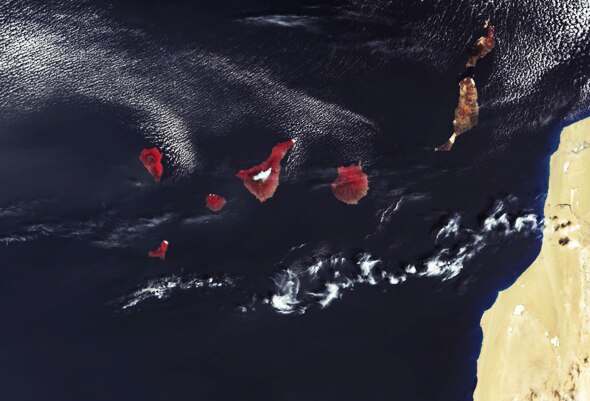Create a free profile to get unlimited access to exclusive videos, sweepstakes, and more!
Red Canaries

I recently posted some very pretty natural color images taken by the new Earth-observing satellite Sentinel-3A, a European bird designed to watch over our changing climate and environment.
But its fleet of detectors also takes data in parts of the electromagnetic spectrum our eyes cannot see, like infrared. Check out the image at the top of this post: It shows the Canary Islands off the coast of Morocco, verdant islands that are vividly green.
… Except here they look red! Why?
Displaying color images is fun. In general, you start with three images taken using three filters—say, one each that lets through blue, green, and red light—and then add them together using software. You can choose how to display each filtered image; to make a “natural color” photo (like the way our eye would see the scene) you make green look green (pick the green channel in the software), blue blue, and red red.
But when you have an image that uses infrared or some other “invisible” color, you can pick how you want to show it. Usually the images are displayed in chromatic order, so the one with the longest wavelengths is shown as red, the shortest as blue, and the one in the middle green.
That’s how the Canary Islands image above was displayed. As it happens, in the near-infrared, vegetation is highly reflective, way more even than for green light. So when you add in the near-IR image, plants look very red. Water is red in IR light, so it looks darker and bluer than usual. Sand is more reflective at redder wavelengths but still reflects well in the green, so it looks yellowish. Clouds reflect everything, so they just look white.
Neat, eh? You may think Canaries are yellow, but clearly they can also be red. Or green.*
But there’s more! North of the Canaries is Madeira, another volcanic island that can be seen in the original, full-size image from Sentinel-3A. Madeira rises just less than 2,000 meters above the ocean surface, enough to affect air flow. Winds from the northeast blew past it during the time Sentinel-3A took this shot, creating a bow wave around the island and a clear spot downwind, and lovely if broken-up von Kármán vortices (fish-tail disturbances in the flow; seriously, click that link because they are so very, very cool), too.
Images like these are important so scientists can keep track of vegetation growth and die-off, of course. But I can use them to show you a world you literally can’t sen otherwise, something I love to do. I like it when everyone wins.
*I’m making a pun here. Canary birds are yellow, but the island group is actually named after dogs, the Latin for which is Canis.


























